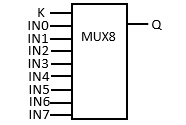![]()
![]() A function calculates a result according to the current value of its inputs. A function has no internal data and is not linked to declared instances. - Select one of the inputs - 8 inputs.
A function calculates a result according to the current value of its inputs. A function has no internal data and is not linked to declared instances. - Select one of the inputs - 8 inputs.
Inputs
|
Inputs |
Data Type |
Description |
|---|---|---|
|
K |
DINT |
Selection command. |
|
IN0 |
ANY |
First input. |
|
IN1 |
ANY |
Second input. |
|
IN2 |
ANY |
Third input. |
|
IN3 |
ANY |
Fourth input. |
|
IN4 |
ANY |
Fifth input. |
|
IN5 |
ANY |
Sixt input. |
|
IN6 |
ANY |
Seventh input. |
|
IN7 |
ANY |
Last input. |
Outputs
|
Output |
Data Type |
Description |
|---|---|---|
|
Q |
ANY |
IN0 or IN1 ... or IN7 depending on K. See Truth Table. |
Truth Table
|
K |
Q |
|---|---|
|
0 |
IN0 |
|
1 |
IN1 |
|
2 |
IN2 |
|
3 |
IN3 |
|
4 |
IN4 |
|
5 |
IN5 |
|
6 |
IN6 |
|
7 |
IN7 |
|
Other |
0 |
Remarks
- In FFLD language, the input rung (EN) enables the selection.
- The output rung keeps the state of the input rung.
- In IL
 "Instruction list"
This is a low-level language and resembles assembly language, the first parameter (selector) must be loaded in the current result before calling the function.
"Instruction list"
This is a low-level language and resembles assembly language, the first parameter (selector) must be loaded in the current result before calling the function. - Other inputs are operands of the function separated by comas.
ST Language
Q := MUX8 (K, IN0, IN1, IN2, IN3, IN4, IN5, IN6, IN7);
FBD Language
FFLD Language
(* the selection is performed only if EN is TRUE *)
(* ENO has the same value as EN *)

IL Language
Not available.
See Also







